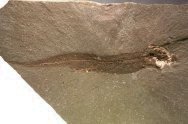|  Description:
The Bear Gulch Limestone of Montana is an important U.S. Paleozoic
Lagerstatte, and is particularly famous for fish fossils. It
is where Richard Lund and Eileen Grogan discovered and worked
over 35 years to describe some 130 fish species, many new to
science, including six 65 species of Paleozoic shark. Many fossils
exhibit exquisite soft tissue preservation due to putative anoxic
conditions in a shallow tropical marine lagoon. Truly a Lagerstätte
in the strictest sense, essentially all Bear Gulch fossils are
rare given that tons of overburden and shale must be excavation
to yield a single fine specimen. Description:
The Bear Gulch Limestone of Montana is an important U.S. Paleozoic
Lagerstatte, and is particularly famous for fish fossils. It
is where Richard Lund and Eileen Grogan discovered and worked
over 35 years to describe some 130 fish species, many new to
science, including six 65 species of Paleozoic shark. Many fossils
exhibit exquisite soft tissue preservation due to putative anoxic
conditions in a shallow tropical marine lagoon. Truly a Lagerstätte
in the strictest sense, essentially all Bear Gulch fossils are
rare given that tons of overburden and shale must be excavation
to yield a single fine specimen.
A
specimens
such as this Harpagofututor volsellorhinus might be found every
other field season, at best.
Harpagofututor is often  described
as having a morphology resembling that of an eel, had few scales,
and apparently dined on shellfish. It is considered to be closely
related to Chimaeras (Order Chimaeriformes), cartilaginous
fishes often called ghost
sharks. Interestingly, the Chimaeras are extant and are thought
to have diverged from their closest relatives, sharks, some
400 million years ago. Today, Chimaeras live in deep water
and are
seldom seen. First
described in 1982, Harpagofututor's
name is related a word for grappling hooks,
to denote a structure
in males shown in the artwork to the right. This is an exquisite
specimen of this ultra rare American Paleozoic shark. described
as having a morphology resembling that of an eel, had few scales,
and apparently dined on shellfish. It is considered to be closely
related to Chimaeras (Order Chimaeriformes), cartilaginous
fishes often called ghost
sharks. Interestingly, the Chimaeras are extant and are thought
to have diverged from their closest relatives, sharks, some
400 million years ago. Today, Chimaeras live in deep water
and are
seldom seen. First
described in 1982, Harpagofututor's
name is related a word for grappling hooks,
to denote a structure
in males shown in the artwork to the right. This is an exquisite
specimen of this ultra rare American Paleozoic shark.
Also
see: Chimaeras Echinochimaera
meltoni female and Echinochimaera
meltoni male from Bear Gulch
Journal
of Paleontology, Volume 71, Number 2 pp337-342. |










